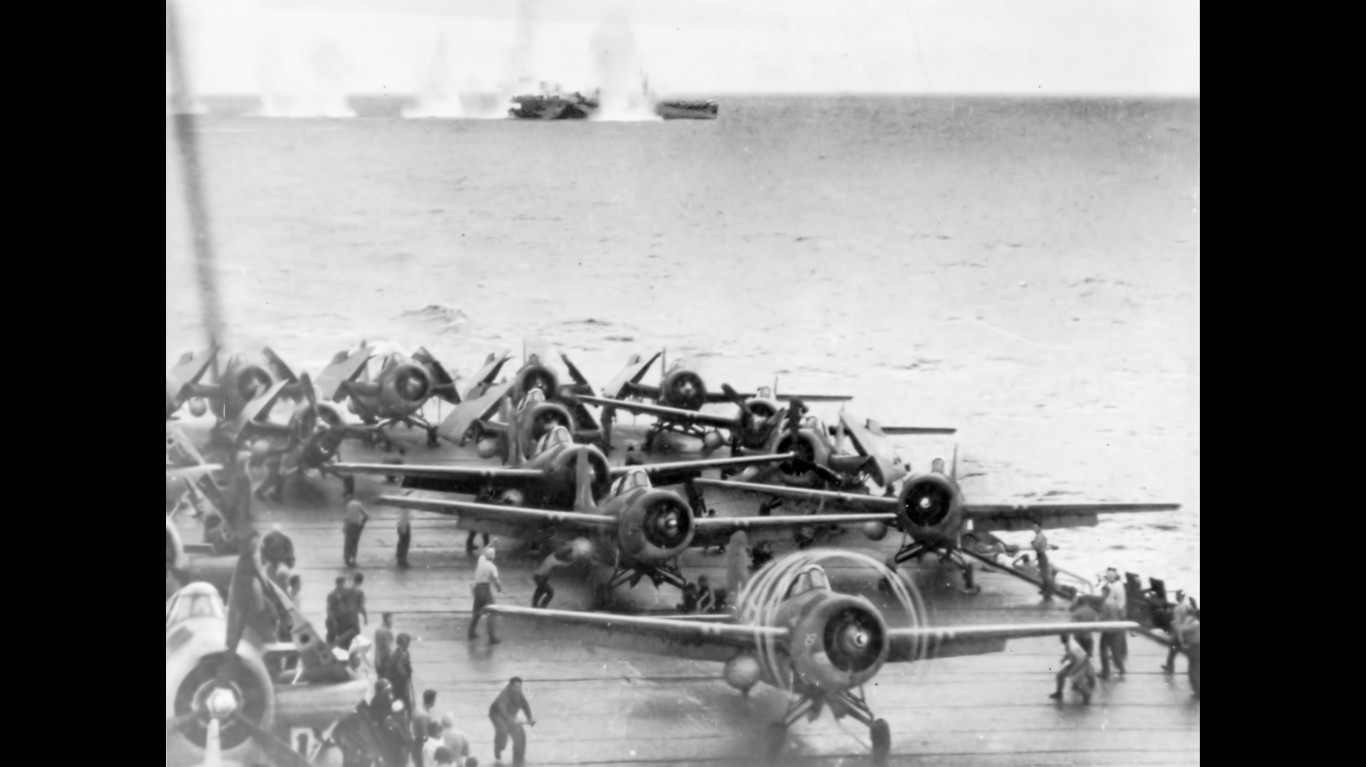
As geopolitical tensions continue to rise across the world, countries like China are building up their naval forces, while the U.S. Navy is constantly upgrading its fleet to maintain a level of preparedness. Navies, after all, have historically played important roles in war and will no doubt continue to do so.
Some of the largest naval battles were waged in World War II, which also WWII marked a turning point in naval warfare with the evolution of carrier-based combat. Using the cutting-edge technology of the time, world powers battled for superiority across the oceans. The United States played a crucial role in many of these battles, especially in the Pacific Theater.
To determine the 15 biggest American naval battles of WWII, 24/7 Wall St. reviewed various historical accounts of naval battles during the war. Naval battles were ranked based on how many warships were engaged in each battle. Supplemental information on when and where these battles took place, notable ships involved, the size and battle order of each armada, and how many ships were sunk in each battle came from various sources.
Two significant encounters in the Pacific Theater include the Battle of Midway and the Battle of Leyte Gulf. The Battle of Midway, which took place from June 4 to 7, 1942, was a decisive moment in the Pacific Theater. The battle, which involved 130 warships, took place six months after the Pearl Harbor attack, with the United States seeking to avenge its losses and shift the tide of war in their favor.
The Imperial Navy sent a large carrier force, while the U.S. Navy committed all its heavy aircraft carriers, reflecting the new emphasis on air power in naval warfare. Many supporting warships and submarines were involved as well. The United States successfully ambushed the Japanese fleet in this encounter, sinking four heavy aircraft carriers and destroying over 300 aircraft. The U.S. lost one aircraft carrier and nearly 150 aircraft. The victory marked the turning point in the Pacific Theater tilting the balance of power in favor of the U.S. (Today, these are the most expensive planes made for the U.S. Navy.)
Another significant battle on this list is the Battle of Leyte Gulf, which took place between October 23 and 26, 1944, and is considered the largest naval battle not only in WWII but in history. With the U.S. moving to reclaim the Philippines and the Japanese hoping to stop their advance, this battle, which involved 279 warships, proved critical in the final stages of the war. (See also, the most pivotal naval battles of all time.)
The Battle of Leyte Gulf was also infamous because the Japanese introduced a new tactic during this battle, the kamikaze, or suicide air attacks. Despite the impact of these attacks, the United States emerged victorious, sinking the four remaining Japanese aircraft carriers, thus crippling Japan’s ability to project naval power.
These encounters would ultimately shift the balance of power in favor of the U.S., leading to Japan’s eventual surrender.
Here’s a look at the biggest American naval battles of WWII.
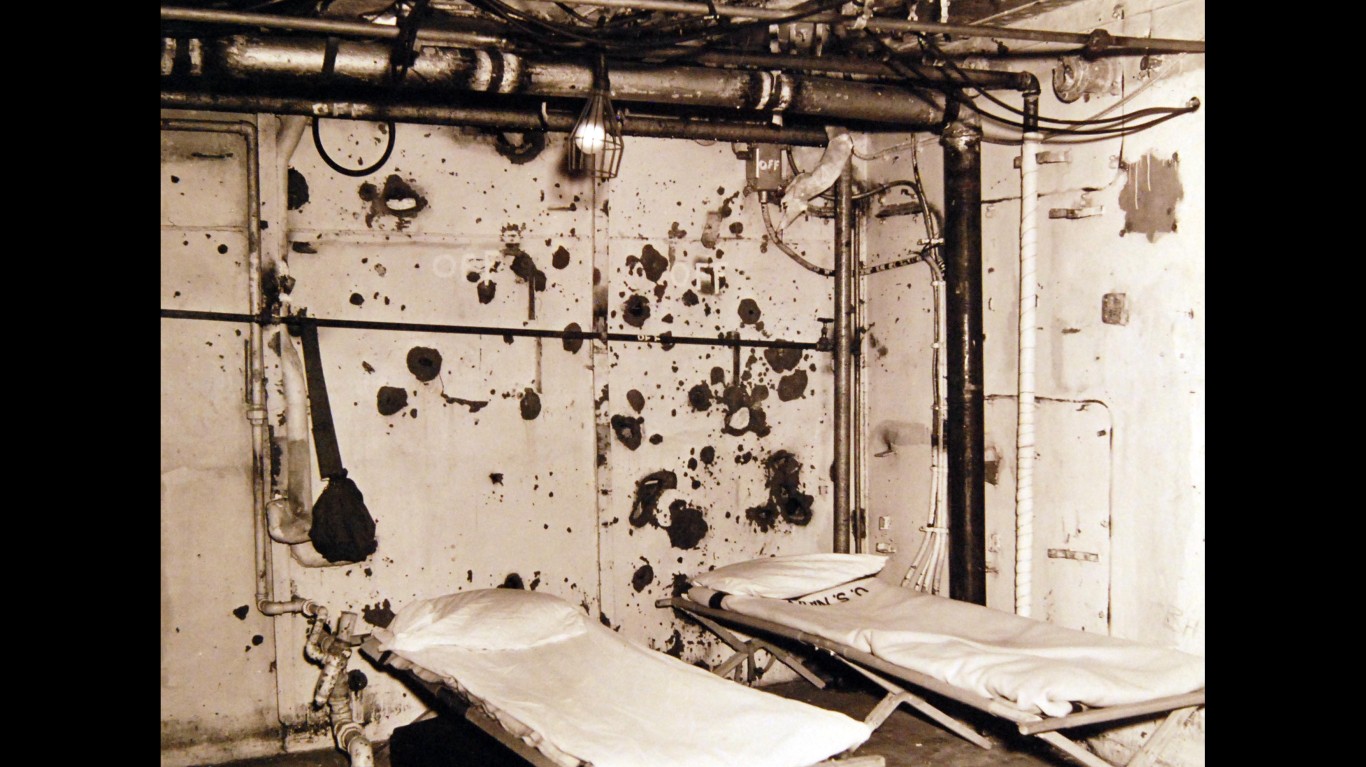
15. Battle of Cape Esperance
> Number of warships involved: 13
> Date: October 11, 1942
> Location: Guadalcanal, Solomon Islands
> Notable ships involved: Furutaka (sunk), Fubuki (sunk), USS Boise (damaged)
> US armada: 2 heavy cruisers, 2 light cruisers, 4 destroyers
> Japanese armada: 3 heavy cruisers, 2 destroyers
> Ships sunk: Japan: 1 heavy cruiser, 1 destroyer; US: 1 destroyer
[in-text-ad]

14. Battle of Tassafaronga
> Number of warships involved: 17
> Date: November 30, 1942
> Location: Guadalcanal, Solomon Islands
> Notable ships involved: USS Minneapolis, USS New Orleans, USS Honolulu
> US armada: 4 heavy cruisers, 1 light cruiser, 4 destroyers
> Japanese armada: 8 destroyers
> Ships sunk: Japan: 1 destroyer; US: 1 heavy cruiser
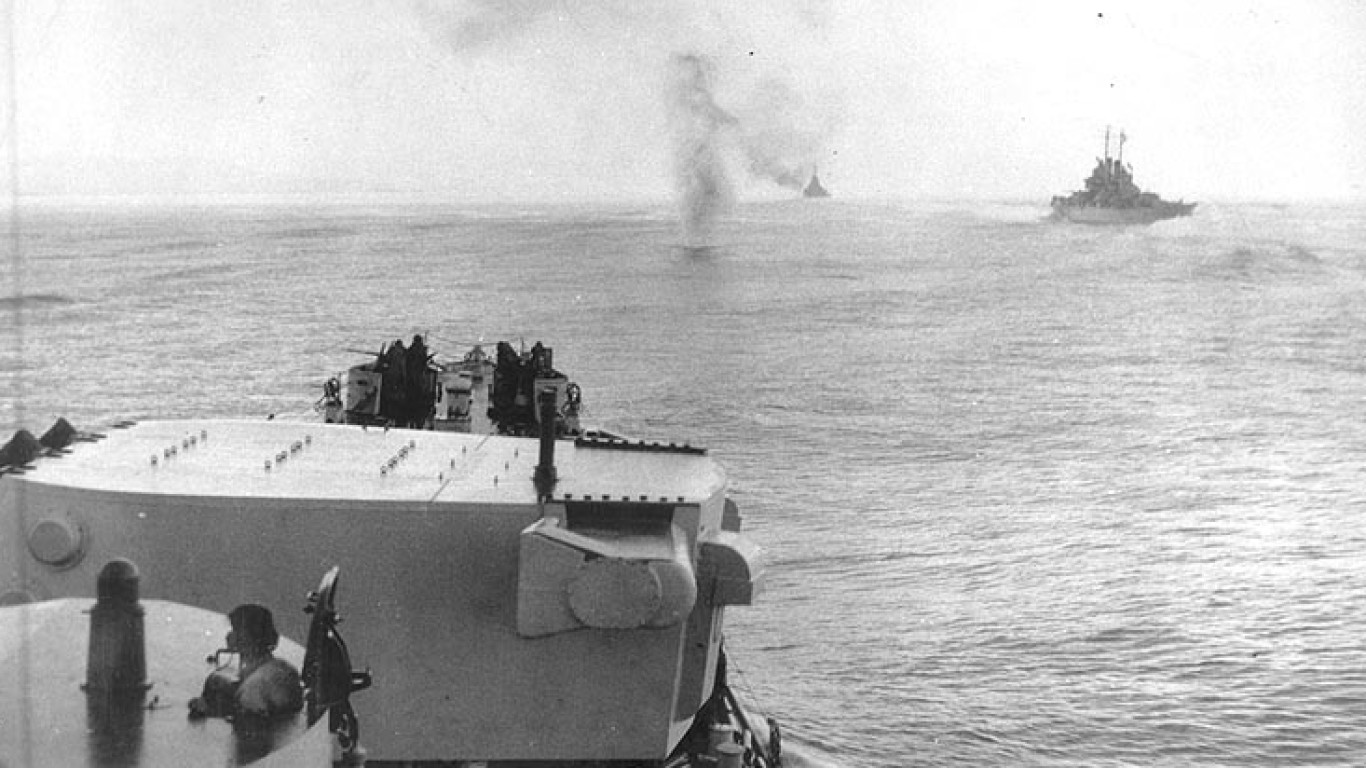
13. Battle of Empress Augusta Bay
> Number of warships involved: 22
> Date: November 1-2, 1942
> Location: Bougainville, Papua New Guinea
> Notable ships involved: Sendai (sunk), Hatsukaze (sunk)
> US armada: 4 light cruisers, 8 destroyers
> Japanese armada: 4 light cruisers, 6 destroyers
> Ships sunk: Japan: 1 light cruisers, 1 destroyer
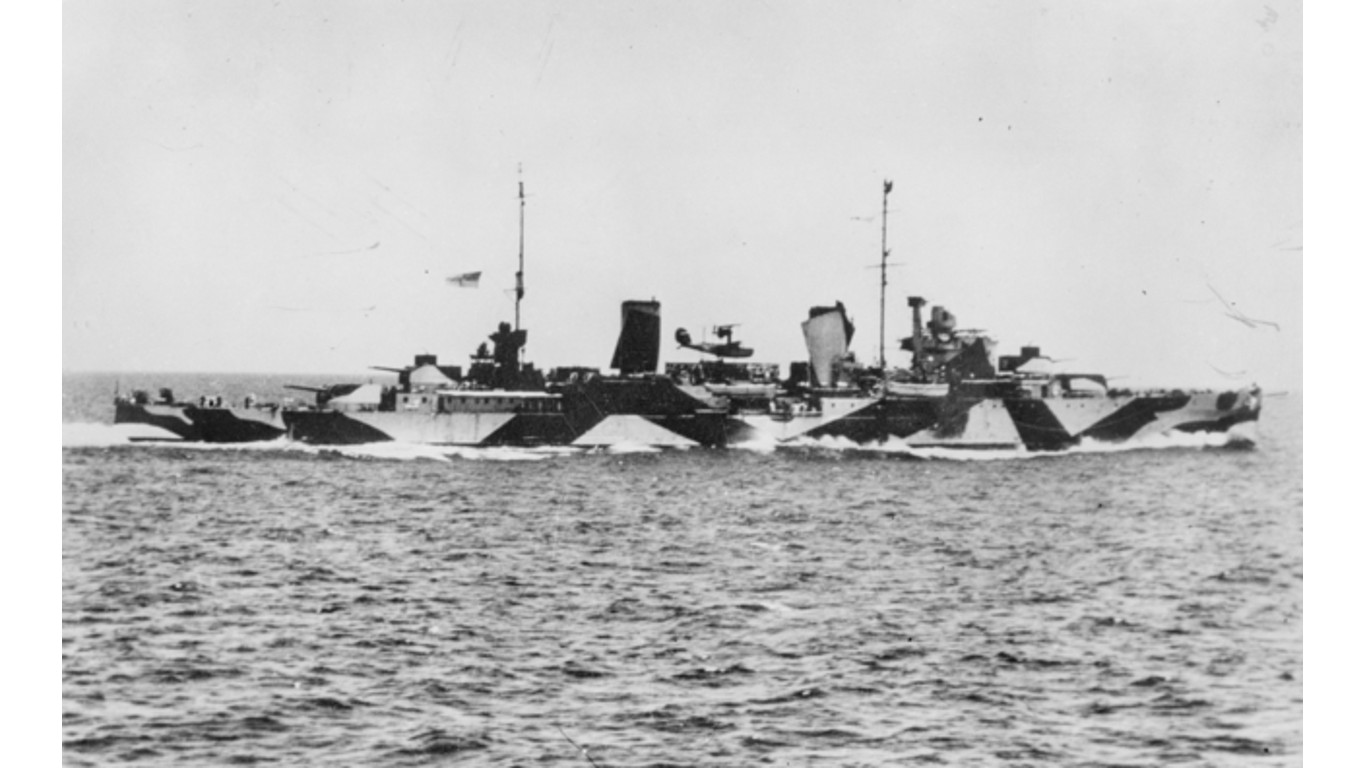
12. Battle of the Sunda Strait
> Number of warships involved: 23
> Date: February 28, 1942
> Location: Sunda Strait, Indonesia
> Notable ships involved: USS Houston (sunk), HMAS Perth (sunk)
> Allied armada: 1 heavy cruiser, 1 light cruiser, 1 destroyer
> Japanese armada: 1 light carrier, 1 seaplane carrier, 5 cruisers, 12 destroyers, 1 minelayer
> Ships sunk: Allies: 1 heavy cruiser, 1 light cruiser, 1 destroyer; Japan: 1 minelayer, 4 troopships
[in-text-ad-2]
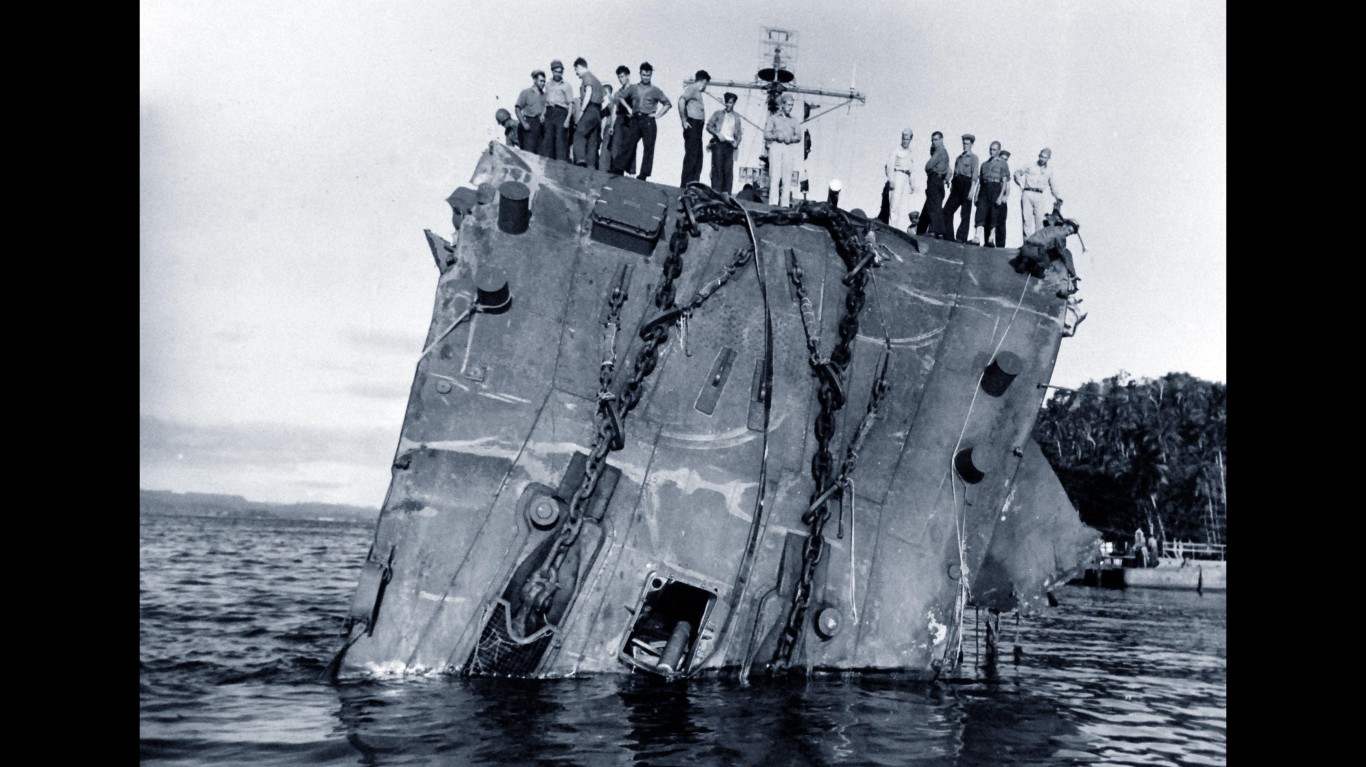
11. Battle of Kolombangara
> Number of warships involved: 24
> Date: July 12-13, 1943
> Location: Kolombangara, Solomon Islands
> Notable ships involved: Jintsu (sunk), USS Honolulu (damaged), USS Saint Louis (damaged)
> US armada: 3 cruisers, 10 destroyers
> Japanese armada: 10 destroyers, 1 transport
> Ships sunk: US: 1 destroyer; Japan: 1 destroyer
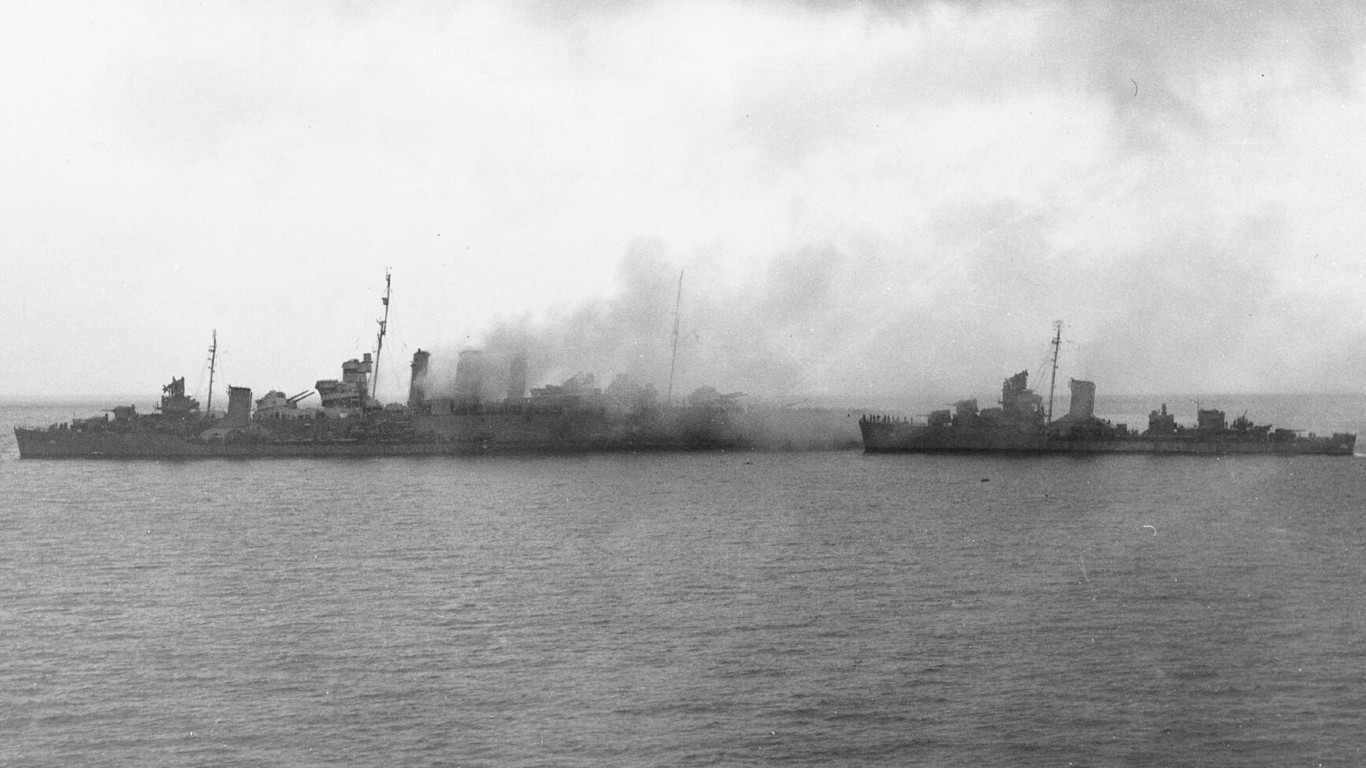
10. Battle of Savo Island
> Number of warships involved: 24
> Date: August 9, 1942
> Location: Savo, Solomon Islands
> Notable ships involved: USS Quincy (sunk), USS Vincennes (sunk), USS Astoria (sunk)
> US armada: 8 cruisers, 8 destroyers
> Japanese armada: 7 cruisers, 1 destroyer
> Ships sunk: US: 3 heavy cruisers
[in-text-ad]

9. Battle of the Balikpapan
> Number of warships involved: 31
> Date: January 24, 1942
> Location: Balikpapan, Borneo
> Notable ships involved: USS John D. Ford, USS Pope, USS Paul Jones
> US armada: 4 destroyers
> Japanese armada: 16 transports, 1 light cruiser, 10 destroyers
> Ships sunk: Japan: 4 transports, 1 patrol boat
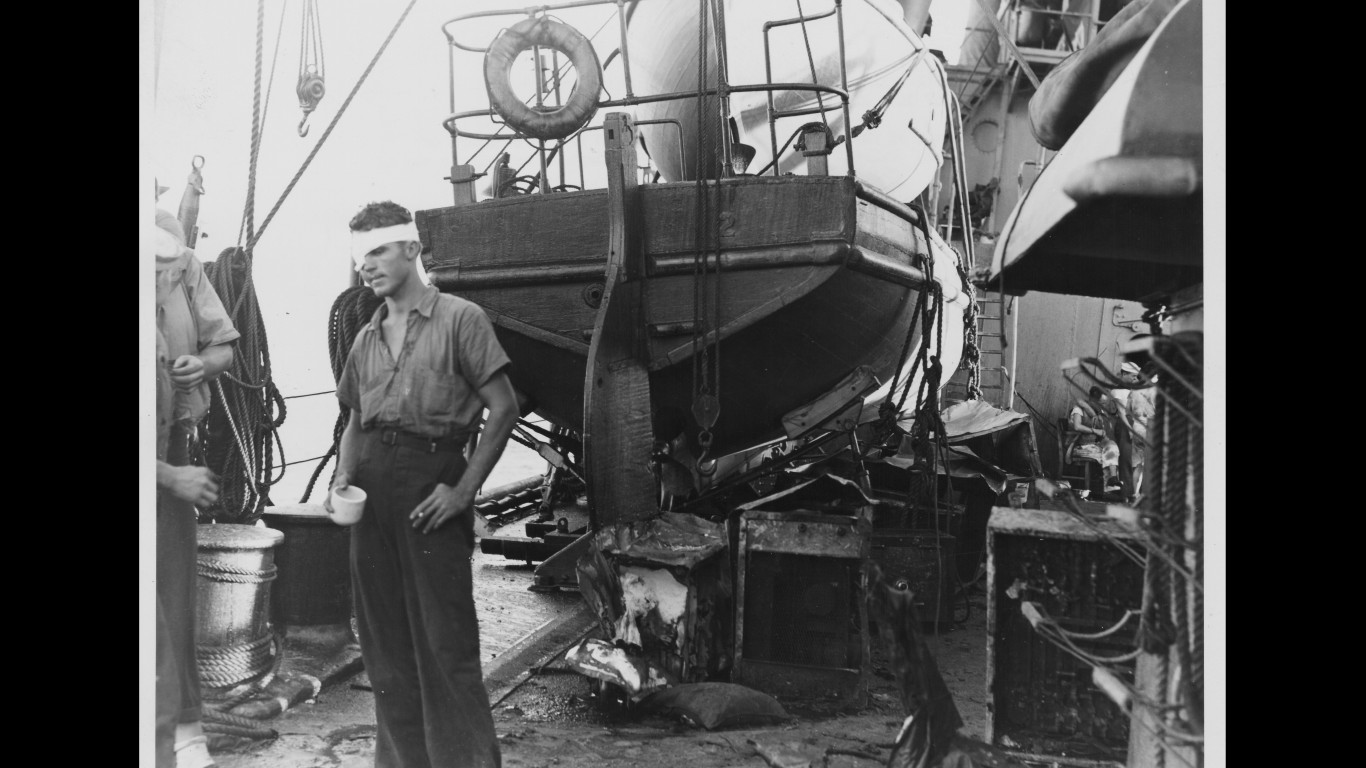
8. Battle of the Java Sea
> Number of warships involved: 42
> Date: February 27, 1942
> Location: Gaspar Strait, Indonesia
> Notable ships involved: USS Houston (damaged), HMAS Perth (damaged)
> Allied armada: 2 heavy cruisers, 3 light cruisers, 9 destroyers
> Japanese armada: 2 heavy cruisers, 2 light cruisers, 14 destroyers, 10 transports
> Ships sunk: Allies: 2 cruisers, 3 destroyers
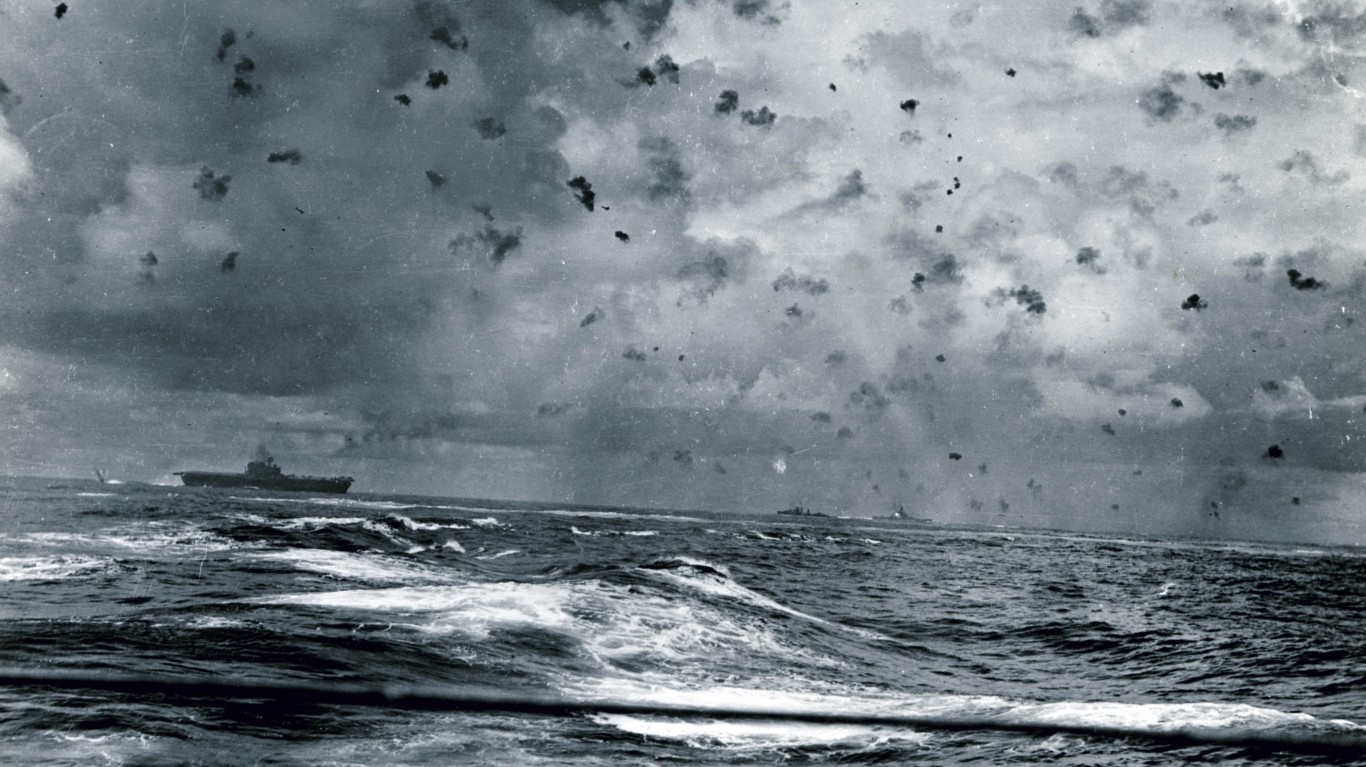
7. Battle of Santa Cruz Islands
> Number of warships involved: 59
> Date: October 26, 1942
> Location: Temotu, Solomon Islands
> Notable ships involved: USS Hornet (sunk), USS Porter (sunk), USS Enterprise (damaged)
> US armada: 2 carriers, 1 battleship, 3 heavy cruisers, 3 antiaircraft light cruisers, 14 destroyers
> Japanese armada: 2 fleet carriers, 2 light carriers, 8 antiaircraft carriers, 2 light cruisers, 22 destroyers
> Ships sunk: US: 1 fleet carrier, 1 destroyer
[in-text-ad-2]

6. Battle of the Eastern Solomons
> Number of warships involved: 65
> Date: August 24, 1942
> Location: Eastern Solomon Islands
> Notable ships involved: Ryujo (sunk), USS Enterprise (damaged), Shokaku
> US armada: 2 carriers, 1 battleship, 3 heavy cruisers, 1 light cruiser, 11 destroyers
> Japanese armada: 3 carriers, 2 battleships, 17 heavy and light cruisers, 25 destroyers
> Ships sunk: Japan: 1 fleet carrier, 1 destroyer
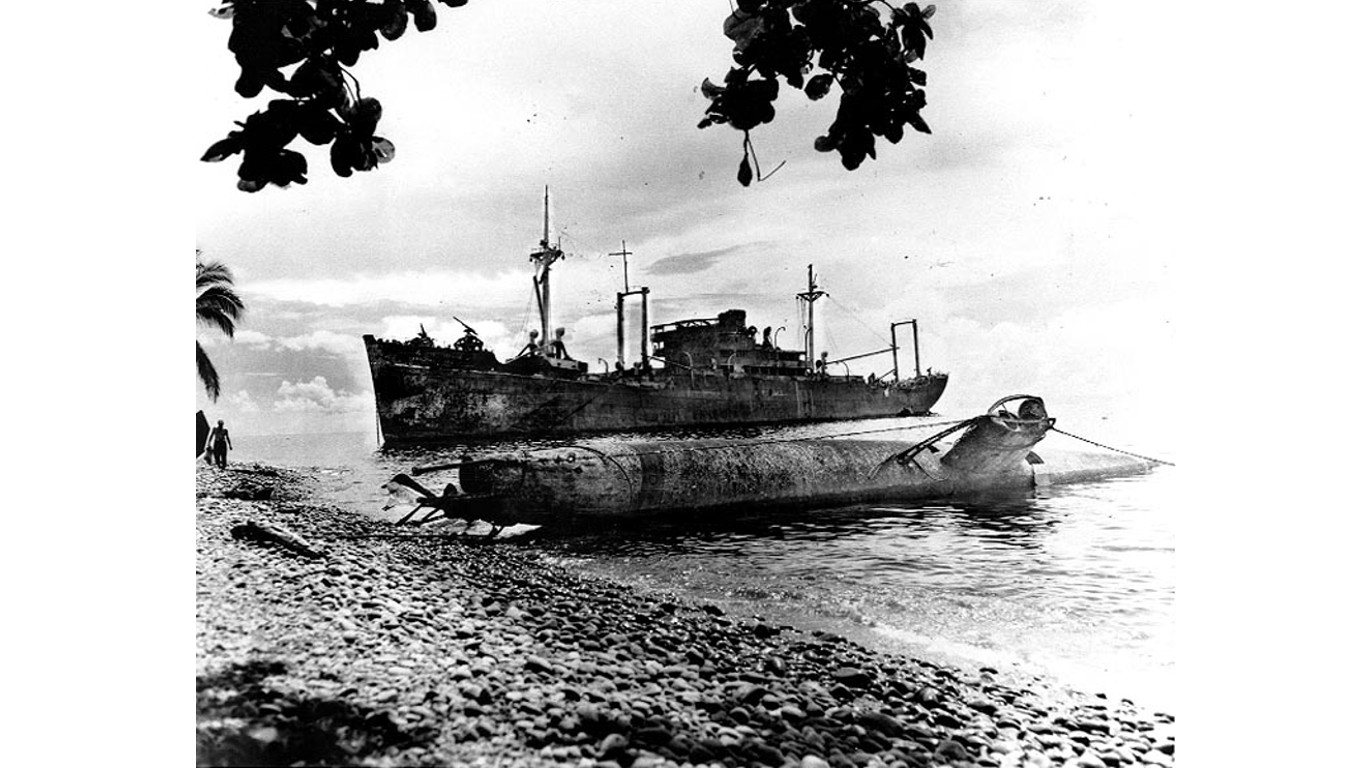
5. Naval Battle of Guadalcanal
> Number of warships involved: 70
> Date: November 12-15, 1942
> Location: Guadalcanal, Solomon Islands
> Notable ships involved: Hiei (sunk), USS Atlanta (sunk), USS Juneau (sunk)
> US armada: 1 aircraft carrier, 4 heavy cruisers, 4 light cruisers, 22 destroyers, 4 transports, 3 cargo vessels
> Japanese armada: 3 battleships, 22 destroyers, 3 patrol boats, 2 light cruisers, 2 heavy cruisers
> Ships sunk: US: 2 cruisers, 7 destroyers; Japan: 2 battleships, 4 cruisers sunk, 8 destroyers sunk, 12 transports
[in-text-ad]
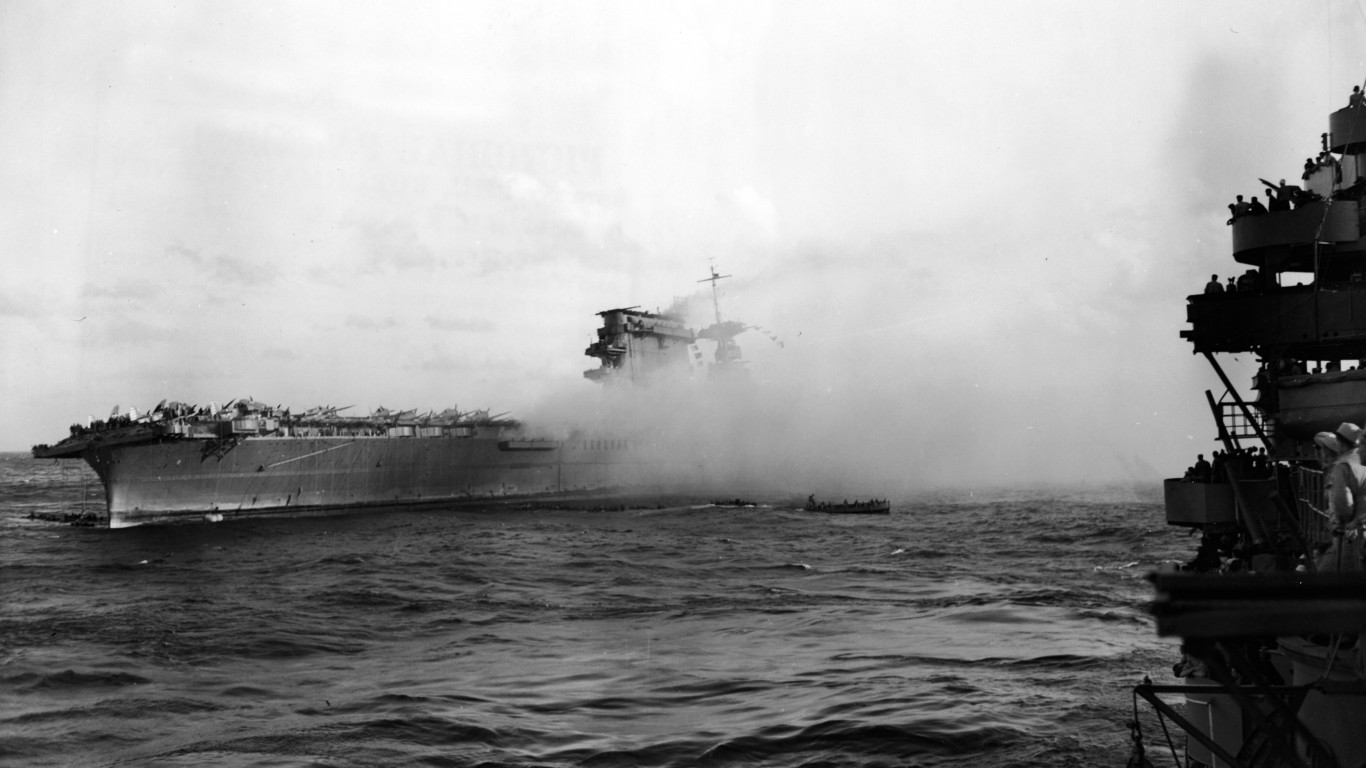
4. Battle of the Coral Sea
> Number of warships involved: 78
> Date: May 4-8, 1942
> Location: Australia
> Notable ships involved: USS Minneapolis, USS Yorktown, USS Lexington (sunk)
> US armada: 2 fleet carriers, 9 cruisers, 13 destroyers, 2 oilers
> Japanese armada: 2 fleet carriers, 1 light carrier, 9 cruisers, 15 destroyers, 5 minesweepers, 2 minelayers, 2 submarine chasers, 3 gunboats, 1 oil tanker, 12 transports
> Ships sunk: US: 1 carrier, 1 oiler, 1 destroyer; Japan: 1 carrier, 1 light carrier, 2 destroyers, 1 cargo ship or transport, 4 gun boats

3. Battle of Midway
> Number of warships involved: 130
> Date: June 4-7, 1942
> Location: Midway Islands
> Notable ships involved: USS Yorktown (sunk), Akagi (sunk), Kaga (sunk), Hiryu (sunk), Soryu (sunk)
> US armada: 3 heavy aircraft carriers, 8 cruisers, 18 destroyers, 19 submarines
> Japanese armada: 4 heavy aircraft carriers, 2 light aircraft carriers, 2 seaplane carriers, 7 battleships, 15 cruisers, 42 destroyers, 10 submarines
> Ships sunk: US: 1 aircraft carrier, 1 destroyer; Japan: 4 aircraft carriers, 1 heavy cruiser
2. Battle of the Philippine Sea
> Number of warships involved: 134
> Date: June 18, 1944
> Location: Mariana Islands
> Notable ships involved: Shokaku (sunk), Taiho (sunk)
> US armada: 7 fleet carriers, 8 light carriers, 7 battleships, 79 other ships
> Japanese armada: 5 fleet carriers, 4 light carriers, 5 battleships, 19 other ships
> Ships sunk: Japan: 3 fleet carriers, 2 oilers
[in-text-ad-2]
1. Battle of Leyte Gulf
> Number of warships involved: 279
> Date: October 23-26, 1944
> Location: Philippine Islands
> Notable ships involved: USS Princeton (sunk), USS Gambier Bay (sunk), USS St. Lo (sunk), Zuikaku (sunk), Zuiho (sunk)
> US armada: 8 fleet carriers, 8 light carriers, 18 escort carriers, 12 battleships, 24 cruisers, 141 destroyers and destroyer escorts
> Japanese armada: 1 fleet carrier, 3 light carriers, 9 battleships, 14 heavy cruisers, 6 light cruisers, 35+ destroyers
> Ships sunk: US: 1 light carrier, 2 escort carriers, 2 destroyers, 1 destroyer escort; Japan: 1 fleet carrier, 3 light carriers, 3 battleships, 10 heavy cruisers, and 11 destroyers
Get Ready To Retire (Sponsored)
Start by taking a quick retirement quiz from SmartAsset that will match you with up to 3 financial advisors that serve your area and beyond in 5 minutes, or less.
Each advisor has been vetted by SmartAsset and is held to a fiduciary standard to act in your best interests.
Here’s how it works:
1. Answer SmartAsset advisor match quiz
2. Review your pre-screened matches at your leisure. Check out the advisors’ profiles.
3. Speak with advisors at no cost to you. Have an introductory call on the phone or introduction in person and choose whom to work with in the future
Thank you for reading! Have some feedback for us?
Contact the 24/7 Wall St. editorial team.
 24/7 Wall St.
24/7 Wall St.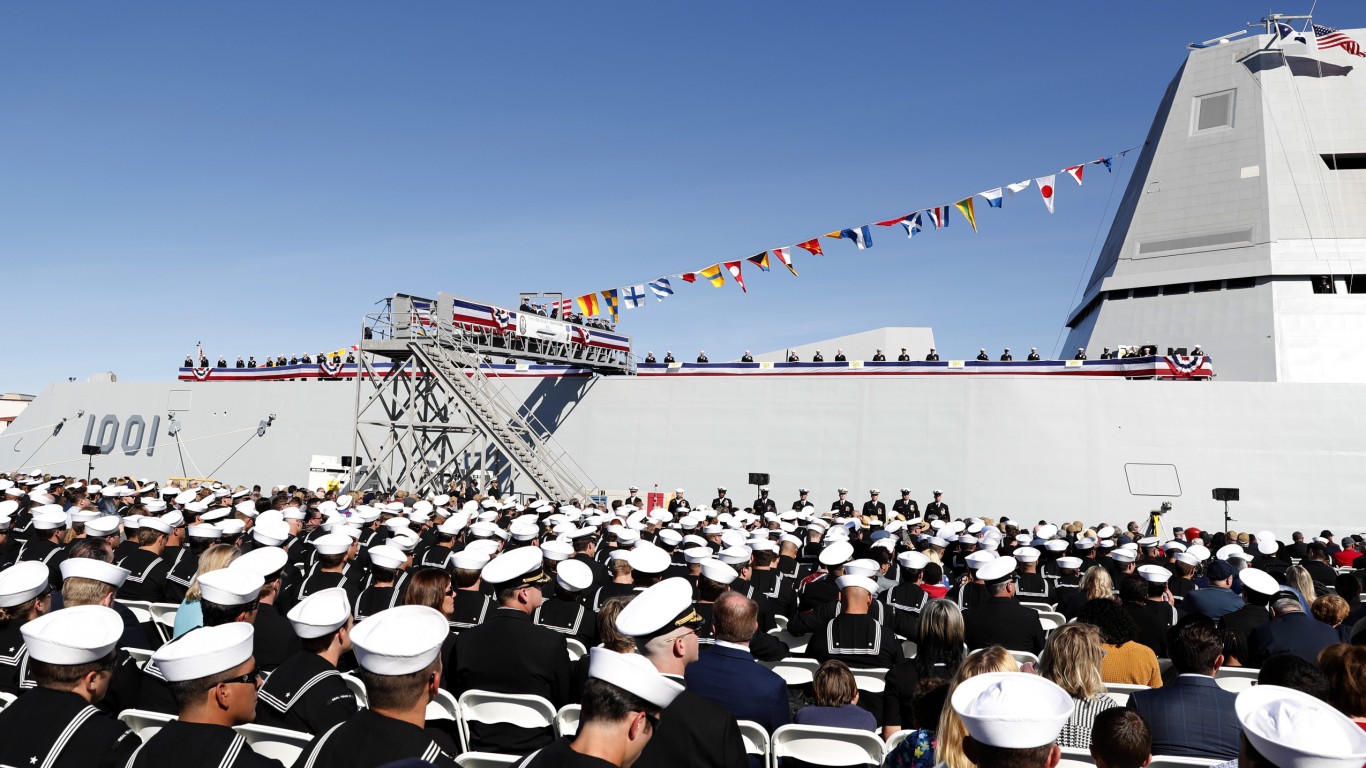 24/7 Wall St.
24/7 Wall St.